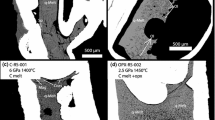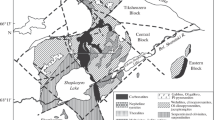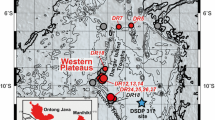Abstract
The origin of the alkaline magmatism, including kimberlites and carbonatites, is believed to be related to deep-seated mantle plumes. A chondritic Earth’s mantle contains very low amounts of alkaline elements, with Na prevailing over K. Consequently, the source of the alkaline rocks cannot be the ‘chondritic’ mantle and most likely a mantle modified by subducted crustal materials. Alkaline magmas and carbonatites appear first in the Mesoarchean (~ 3 Ga) and possibly coincided with the onset of plate tectonics. Melting and degassing of subducted slabs into the deep mantle caused widespread metasomatism and formation of reservoirs enriched in the alkaline and lithophile trace elements. These served as sources of alkaline and carbonatitic magmas, and from ~ 2 Ga onwards of kimberlite magmas. Theoretical and experimental modeling predict the lower mantle and transition zone to be largely composed of bridgmanite, ferropericlase, Ca-Si-perovskite, ringwoodite, wadsleyite, majorite, NAL (a hexagonal aluminous phase of the lower mantle containing Na, Al and K), breyite and carbonates. The alkaline elements, isomorphic in CaSi-perovskite, bridgmanite and NAL, can be released during the ascent of mantle plume and transferred to the melt/fluid-enriched reservoir of carbonatites and alkaline magmas. At ~ 600 km depth where majorite is stable, an extensive fractionation of K and Na occurs, as the partitioning coefficient of Na is an order of magnitude larger than that of K. This results in K enrichment of the metasomatic melt/fluid that contribute to prospective sources of kimberlitic and other deep-mantle K magmas.

(modified from Kogarko 2008)

(modified from Torsvik et al. 2010)

Modified from Dorfman (2016)
Similar content being viewed by others
References
Anzolini C, Angel RJ, Merlini M, Derzsi M, Tokár K, Milani S, Krebs MY, Brenker FE, Nestola F, Harris JW (2016) Depth of formation of CaSiO3-walstromite included in super-deep diamonds. Lithos 265:138–147
Arzamastsev AA, Bea F, Glaznev VN, Arzamastseva LV, Montero P (2001) Kola alkaline province in the Paleozoic: evaluation of primary mantle magma composition and magma generation conditions. Russ J Earth Sci 3:1–32
Bell K, Lavecchia G, Rosatelli G (2013) Cenozoic Italian magmatism e isotope constraints for possible plume-related activity. J S Am Earth Sci 41:22e40
Bindi L, Tamarova A, Bobrov AV, Sirotkina EA, Tschauner O, Walter MJ, Irifune T (2016) Incorporation of high amounts of Na in ringwoodite: Possible implications for ransport of alkali into lower mantle. Am Mineral 101:483–486
Blaustein R (2016) The Great Oxidation Event. Bio Sci 66(3):189–195
Condie KC (2018) A Planet in transition: the onset of plate tectonics on Earth between 3 and 2 Ga? Geosci Front 9:51e60
Corgne A, Wood BJ (2004) Trace element partitioning between majoritic garnet and silicate melt at 25 GPa. Phys Earth Planet In 143–144:407–419
Corgne A, Armstrong LS, Keshav S, Fei Y, McDonough WF, Minarik WG, Moreno K (2012) Trace element partitioning between majoritic garnet and silicate melt at 10–17 GPa: Implications for deep mantle processes. Lit has 148:128–141
Corgne A, Liebske C, Wood BJ, Rubie DC, Frost DJ (2005) Silicate perovskite-melt partitioning of trace elements and geochemical signature of a deep perovskitic reservoir. Geochim Cosmochim Ac 69(2):485–496
Dasgupta R, Hirschmann MM (2010) The deep carbon cycle and melting in Earth’s interior. Earth Planet Sc Lett 298:1–13
Domanik’ KJ, Holloway JR (1996) The stability and composition of phengitic muscovite and associated phases from 5.5 to 11 GPa: Implications for deeply subducted sediments. Geochim Cosmochim Ac 60(21):4133–4150
Dorfman SM (2016) Phase diagrams and thermodynamics of lower mantle materials. In: Terasaki H, Fischer RA (eds) Deep Earth: Physics and Chemistry of the Lower Mantle and Core. Wiley, pp 241–252
Downes H, Balaganskaya E, Beard A, Liferovich R, Demaiffe D (2005) Petrogenetic processes in the ultramafic, alkaline and carbonatitic magmatism in the Kola alkaline province: A review. Lithos 85:48–75
Fedorenko V, Czamanske G, Zen’ko T, Budahn J, D Siems (2000) Field and geochemical studies of the melilite-bearing arydzhangsky suite, and an overall perspective on the Siberian alkaline-ultramafic flood-volcanic rocks. Int Geol Rev 42(9):769–804
Foley SF (1992) Petrological characterization of the source components of potassic magmas: geochemical and experimental constraints. Lithos 28:187–204
Frolov AA, Lapin AV, Tolstov AV, Zinchuk NN, Belov SV, Burmistrov AA (2005) Carbonatites and kimberlites. NIA-Priroda, Moscow, p 540
Galimov EM (2005) Redox evolution of the Earth caused by a multi-stage formation of its core. Earth Planet Sci Lett 233:263–276
Garnero EJ, Lay T, McNamara AK (2007) Implications of lower-mantle structural heterogenety for existence and nature of whole-mantle plumes. In Foulger GR, Jurdy DM (eds) Plates, Plumes, and Planetary Processes. Geol Soc Am Spec Pap 430, pp 79–109
Goodenough KM, Upton BGJ, Ellam RM (2002) Long-term memory of subduction processes in the lithospheric mantle: evidence from the geochemistry of basic dykes in the Gardar province of South Greenland. J Geol Soc Lond 159:705–714
Green DH, Falloon TJ, Taylor WR (1987) Mantlederived magmas: Roles of variable source peridotite and variable C–H–O fluid comparisons. In: Mysen B (ed) Magmatic Processes: Physicochemical Principles. Geochem Soc Spec Publ 1:158–172
Harlow GE (1997) K in clinopyroxene at high pressure and temperature: An experimental study. Am Mineral 82:259–269
Harte B, Harris J, Hutchison M, Watt G, Wilding M (1999) Lower mantle mineral associations in diamonds from São Luiz, Brazil. In: Fei Y, bertka CM, Mysen BO (eds) Mantle Petrology: Field observations and high-pressure experimentation: A tribute to Francis R.(Joe) Boyd 6. Geochem Soc Special Publ 6, pp 125–153
Hayman PC, Kopylova MG, Kaminsky FV (2005) Lower mantle diamonds from Rio Soriso (Juina area, Mato Grosso, Brazil). Contrib Mineral Petr 149(4):430–445
Hofmann AW (1997) Mantle geochemistry: The message from oceanic volcanism. Nature 385(6613):219–229
Holland HD (2006) The oxygenation of the atmosphere and oceans. Philos Trans R Soc Lond B Biol Sci 361:903–915
Hutchison MT (1997) Constitution of the deep transition zone and lower mantle shown by diamonds and their inclusions. Unpublished PhD thesis, University of Edinburgh, UK
Janse, Sheahan PA (eds) (1995) Catalogue of world wide diamond and kimberlite occurrences: a selective and annotative approach. J Geochem Explor 53(1–3):73–111
Jensen SM, Secher K, Rasmussen TM, Schjøth F (2004) Diamond exploration data from West Greenland: 2004 update and revision. Danmarks og Grønlands. Geologiske Undersøgelse Rapport 2004/117:90
Kaminsky FV (2017) The Earth’s lower mantle. Composition and structure. Springer Geology. Springer International Publishing AG KM Diamond Exploration Ltd. West Vancouver, p 331
Kaminsky FV (2018) Water in the Earth’s lower mantle.Geochem Int + 56(12):1117–1134
Kato C, Hirose K, Komabayashi T, Ozawa H, Ohishi Y (2013) NAL phase in K-rich portions of the lower mantle. Geophys Res Lett 40:5085–5088
Kawamoto T, Hervig RL, Holloway JR (1996) Experimental evidence for a hydrous transition zone in the early Earth’s mantle. Earth Planet Sc Lett 142:587–592
Kesson SE, Fitzgerald JD, Shelley JM (1987) Mineralogy and dynamics of a pyrolite of the lower mantle. Nature 393:252–255
Kogarko LN (2008) Kimberlite magmatism in the Earth’s history: Diamond potential and genesis. Dokl Earth Sci 418(1):73–75
Kogarko LN, Veselovsky RV (2019) Geodynamic regimes of carbonatite formation according to the paleo-reconstruction method. Dokl Earth Sci 484(1):25–27
Kogarko LN, Henderson CMB, Pacheco H (1995) Primary Ca-rich carbonatite magma and carbonate-silicate-sulphide liquid immiscibility in the upper mantle. Contrib Mineral Petrol 121:267–274
Kogarko LN, Lahaye Y, Brey GP (2009) Plume-related mantle source of super-large rare metal deposits from the Lovozero and Khibina massifs on the Kola Peninsula, Eastern part of Baltic Shield: Sr, Nd and Hf isotope systematics. Mineral Petrol 98:197–208
Kogarko LN, Plant DA, Henderson CMB, Kjarsgaard BA (1991) Na-rich carbonate inclusions in perovskite and calzirtite from the Guli intrusive Ca-carbonatite, polar Siberia. Contrib Mineral Petrol 109:124–129
Kuzmin MI, Yarmolyuk VV, Ernst RE (2016) Tectonic activity of the early Earth (4.56–3.4(2.7?) Ga). Russ Geol Geophys––57(5):639–652
Lehnert K, Su Y, Langmuir CH, Sarbas B, Nohl U (2000) A global geochemical database structure for rocks. Geochem Geophys Geosyst 1:1012. doi:https://doi.org/10.1029/1999GC000026
Litasov K, Ohtani E (2005) Phase relations in hydrous MORB at 18–28 GPa: Implications for heterogeneity of the lower mantle. Phys Earth Planet In 150:239–263
Liu Z, Irifune T, Nishi M, Tange Y, Arimoto T, Shinmei T (2016) Phase relations in the system MgSiO3–Al2O3 up to 52 GPa and 2000 K. Phys Earth Planet In 257:18–27
Nasdala L, Brenker FE, Glinnemann J, Hofmeister W, Gasparik T, Harris JW, Stachel T, Reese I (2003) Spectroscopic 2D-tomography: Residual pressure and strain around mineral inclusions in diamonds. Eur J Mineral 15:931–935
Navon O, Hutcheon ID, Rossman GR, Wasserburg GJ (1988) Mantle-derived fluids in diamond micro-inclusions. Nature 335:784–789
Palme H, O’Neill (2014) Cosmochemical estimates of mantle compositin. In: Turekian K, Holland H (eds) Treatise on Geochemistry. 2nd edn, vol 3, pp 1–39
Rosatelli G, Humphreys-Williams E, Wall F, Castorina F, Perna MG, Stoppa F (2022) The Calatrava paradox to decipher the origin of carbonatites: A petrological insight on Finca La Nava, Calatrava Province (central Spain). Lithos 416–417:106649
Shirey SB, Richardson SH (2011) Start of the Wilson cycle at 3 Ga shown by diamonds from subcontinental mantle. Science 333:434–436
Shirey SB, Richardson SH, Harris JW (2004) Age, paragenesis and composition of diamonds and evolution of the Precambrian mantle lithosphere of southern Africa. South Afr J Geol 107:91–106
Smith EM, Shirey SB, Nestola F, Bullock ES, Wang J, Richardson SH, Wang W (2016) Large gem diamonds from metallic liquid in Earth’s deep mantle. Science 354(6318):1403–1405
Sobolev NV, Yefimova ES, Channer DMDeR, Anderson PFN, Barron KM (1998) Unusual uppermantle beneath Guaniamo, Guyana shield, Venezuela: Evidence from diamond inclusions. Geology 26:971–974
Stachel T, Brey GP, Harris JW (2000a) Kankan diamonds (Guinea) I: from the lithosphere down to the transition zone. Contrib Mineral Petr 140:1–115
Stachel T, Harris JW, Brey GP, Joswig W (2000b) Kankan diamonds (Guinea) II: Lower mantle inclusion parageneses. Contrib Mineral Petr 140(1):16–27
Stern RJ (2008) Modern-style plate tectonics began in Neoproterozoic time: An alternative interpretation of Earth’s tectonic history. In: Condie KC, pease V (eds) When Did Plate Tectonics Begin on Planet Earth? Geol Soc Am Spec Publ 440, pp 265–280
Stoppa F, Jones AP, Sharygin VV (2009) Nyerereite from carbonatite rocks at Vulture volcano: implications for mantle metasomatism and petrogenesis of alkali carbonate melts. Cent Eur J Geosci 1(2):131–151
Stoppa F, Schiazza M, Rosatelli G, Castorina F, Sharygin VV, Ambrosio FA, Vicentinia N (2019) Italian carbonatite system: From mantle to ore-deposit. Ore Geol Rev 114:103041
Torsvik T, Burke K, Steinberger B, Webb S, Ashwal L (2010) Diamonds sampled by plumes from the core–mantle boundary. Nature 466:352–355
Upton BGJ, Emeleus CH (1987) Mid-Proterozoic alkaline magmatism in southern Greenland: the Gardar province. In: Fitton JG, Upton BGJ (eds) Alkaline Igneous Rocks. Geol Soc London Spec Publ 30, pp 449–471
Weiss Y, Kiflawi I, Navon O (2010) IR spectroscopy: Quantitative determination of the mineralogy and bulk composition of fluid microinclusions in diamonds. Chem Geol 275(1–2):26–34
Woodland AB, Girnis AV, Bulatov VK, Brey GP, Höfer HE (2020) Breyite inclusions in diamond: experimental evidence for possible dual origin. Eur J Mineral 32:171–185
Woolley AR, Kjarsgaard BA (2008) Carbonatite occurrences of the world: Map and database. Geol Surv Canada, open file 5796
Wyllie PJ (1989) Origin of Carbonatites: Evidence from Phase Equilibrium Studies. In: Bell K (ed) Carbonatites: genesis and evolution. Unwin Hyman, London, pp 500–545
Zaitsev AN (2010) Nyerereite from calcite carbonatite at the Kerimasi volcano, Northern Tanzania.Geol Ore Deposit + 52(7):630–640
Zartman RE, Kogarko LN (2017) Lead isotopic evidence for interaction between plume and lower crust during emplacement of peralkaline Lovozero rocks and related rare-metal deposits, East Fennoscandia, Kola Peninsula, Russia. Contrib Mineral Petrol 172:32
Zedgenizov DA, Shatsky VS, Panin AV, Evtushenko OV, Ragozin AL, Kagi H (2015) Evidence for phase transitions in mineral inclusions in superdeep diamonds of the São Luiz deposit (Brazil). Russ Geol Geophys––56:296–305
Zhang Z, Li S, Wang G, Li X, Wang G, Suo Y, Santosh M, Guo L (2020) Plume interaction and mantle heterogeneity: A geochemical perspective. Geosci Front 11:1571–1579
Acknowledgements
The author is sincerely grateful to Lalchand (or Lalou) G. Gwalani for many stimulating discussions of various topics related to advanced geochemistry and mineralogy, and his continuing help and support. I will keep a long memory of the wonderful scientist and person – Lalou Gwalani. Thanks are also due to Gerhard Brey, Vadim Kamenetsky, Alan Woodland and Felix V. Kaminsky for many helpful comments and suggestions. Constructive reviews of two anonymous peers and comments by Guest Editor Kirtikumar R. Randive are gratefully acknowledged. This work was supported by Ministry of Science and Higher Education of the Russian Federation (grant № 13.1902.21.008, agreement 075-15-2020-802).
Author information
Authors and Affiliations
Additional information
Editorial handling: K. R. Randive.
Publisher’s Note
Springer Nature remains neutral with regard to jurisdictional claims in published maps and institutional affiliations.
Rights and permissions
Springer Nature or its licensor holds exclusive rights to this article under a publishing agreement with the author(s) or other rightsholder(s); author self-archiving of the accepted manuscript version of this article is solely governed by the terms of such publishing agreement and applicable law.
About this article
Cite this article
Kogarko, L.N. Plume related kimberlites and carbonatites. Miner Petrol 117, 497–503 (2023). https://doi.org/10.1007/s00710-022-00789-9
Received:
Accepted:
Published:
Issue Date:
DOI: https://doi.org/10.1007/s00710-022-00789-9




